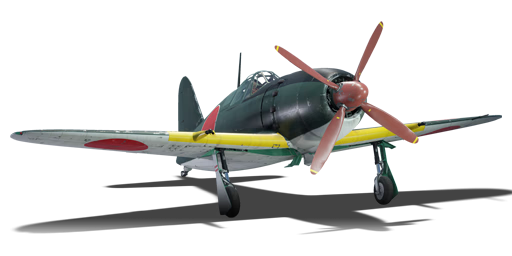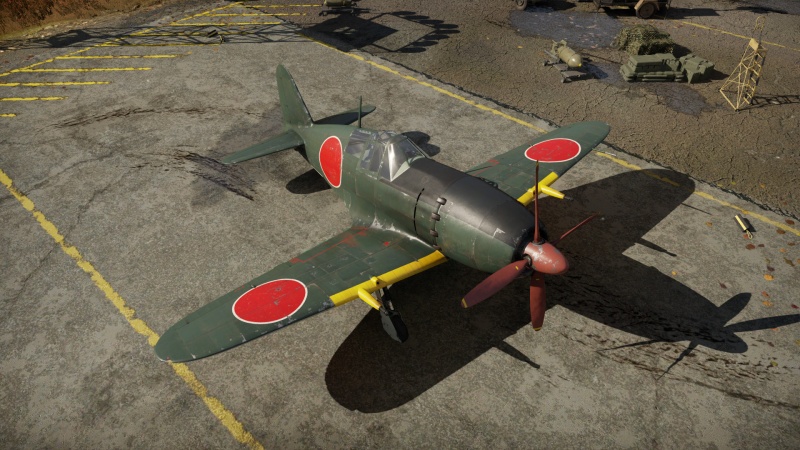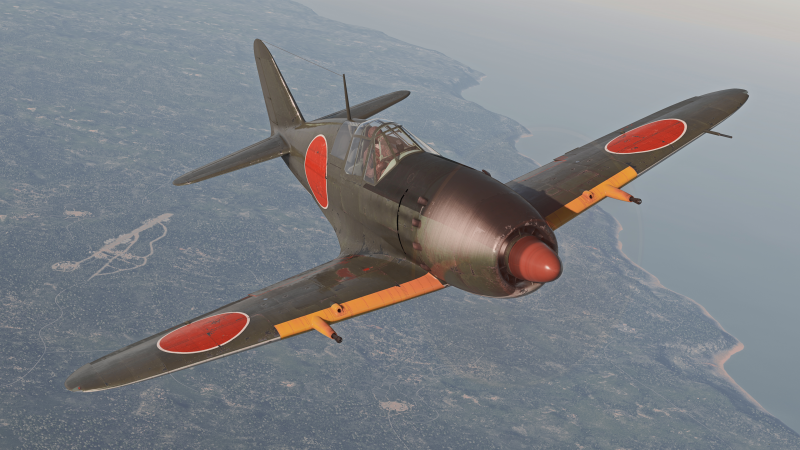J2M5 30mm
| This page is about the premium Japanese fighter J2M5 30mm. For other versions, see J2M (Family). |
Contents
Description
The J2M5 Model 33 (30 mm), designated as Raiden Mod.33 (Prototype) (雷電三三型 (原型)), is a prototype of the J2M5 replacing the four 20 mm cannons with two 30 mm Type 5 cannons. Due to lack of material and manpower, as well as constant bombing, it never entered production lines.
It was introduced in Update 1.51 "Cold Steel". While offering the same flight characteristics as the Raiden it was based on, its armament is of a different calibre, both physically and in usage. The Type 5 30 mm's this J2M5 carries offer a lot of punch for a very limited ammo capacity, so it's up to the pilot to make every trigger pull count.
- Nicknames
- Official Designation: 雷電 (Raiden, "Lightning Bolt")
- Allied reporting name: Jack
General info
Flight performance
| Characteristics | Max Speed (km/h at 6,580 m) |
Max altitude (metres) |
Turn time (seconds) |
Rate of climb (metres/second) |
Take-off run (metres) | |||
|---|---|---|---|---|---|---|---|---|
| AB | RB | AB | RB | AB | RB | |||
| Stock | 585 | 569 | 11500 | 20.2 | 20.6 | 12.9 | 12.9 | 300 |
| Upgraded | 646 | 615 | 18.5 | 19.0 | 23.9 | 17.5 | ||
Details
| Features | ||||
|---|---|---|---|---|
| Combat flaps | Take-off flaps | Landing flaps | Air brakes | Arrestor gear |
| ✓ | ✓ | ✓ | X | X |
| Limits | ||||||
|---|---|---|---|---|---|---|
| Wings (km/h) | Gear (km/h) | Flaps (km/h) | Max Static G | |||
| Combat | Take-off | Landing | + | - | ||
| 820 | 350 | 488 | 454 | 280 | ~12 | ~9 |
| Optimal velocities (km/h) | |||
|---|---|---|---|
| Ailerons | Rudder | Elevators | Radiator |
| < 400 | < 400 | < 460 | > 324 |
| Compressor (RB/SB) | ||
|---|---|---|
| Setting 1 | ||
| Optimal altitude | 100% Engine power | WEP Engine power |
| 1,800 m | 1,510 hp | 1,812 hp |
| Setting 2 | ||
| Optimal altitude | 100% Engine power | WEP Engine power |
| 5,750 m | 1,400 hp | 1,680 hp |
| Setting 3 | ||
| Optimal altitude | 100% Engine power | WEP Engine power |
| 6,200 m | 1,310 hp | 1,572 hp |
Survivability and armour
- 70 mm Bulletproof glass - Armoured windscreen
- 8.5 mm Steel plate in pilot's headrest
Modifications and economy
Armaments
Offensive armament
The J2M5 30mm is armed with:
- 2 x 30 mm Type 5 navy cannons, wing-mounted (42 rpg = 84 total)
Universal belts contain the most HEF rounds, including HEF-I, and a tracer for ease of aim.
Suspended armament
The J2M5 30mm can be outfitted with the following ordnance:
- Without load
- 2 x 60 kg Navy Type 97 Number 6 bombs (120 kg total)
Usage in battles
The premium J2M5 with 2 x 30 mm cannons sits at a favourable battle rating. Although a stubby and small aircraft, the Mitsubishi J2M Raiden can be considered one of the best Japanese fighters. Unlike its predecessors, the premium variant of the J2M5 features a deadly armament of two 30 mm cannons. However, the main advantage the Raiden has over its Allied counterparts is its climb rate. In Realistic Battles, the J2M5 can climb to higher altitudes very quickly, especially when given an air start. This facet of the Raiden's performance is particularly exemplified in the J2M5, the last in-game variant of the Raiden that features the greatest performance of the series. This is partially due to its mechanically-driven supercharger which allows the J2M5 to perform at high altitude. Once at a high altitude, it becomes possible to choose when, where, and who you want to fight. The premium J2M5's 30 mm cannons may initially seem rather lacklustre due to the low ammo count but they do an impressive amount of damage upon a successful hit. Generally, the J2M5 performs similarly to the early Fw 190 A variants, having a deadly armament, good roll rate, low top speed, but higher climb rate. The J2M5 differs from this rule slightly as it was built for speed and high-altitude performance. The Raiden is best used as an energy fighter instead of turning and burning all its built up speed in turns, attack enemies from a higher altitude and then regain that altitude once the attack has been delivered. The J2M5 excels at Boom & Zoom due to its high rate of climb, deadly armament, and high altitude characteristics.
Sharing this role with other energy fighters such as the Fw 190 D-13, the Raiden's main downside is its lack of manoeuvrability. Similar to its aforementioned German counterpart, the Raiden struggles to beat enemies in turn fights, especially Spitfires. If caught in a sticky situation, the Raiden pilot may choose to dive away or seek help from teammates. Trying to fight an enemy Spitfire in a turning battle with any J2M is a terrible idea unless the enemy aircraft is damaged or many teammates are nearby. Moreover, the J2M's high-speed manoeuvrability is very poor; often, it becomes a matter of life and death when pulling out of a high-speed dive as the Raiden's elevator authority at high speeds is lacking. The entire aircraft locks up at excess speeds of 645 km/h (400 mph). It can be very difficult to pull out of a dive, roll, or turn when at high speeds with the J2M. The Raiden's manoeuvrability is more or less on par with its enemies in Simulator Battles, for the most part.
The Raiden pilot may also find him or herself outclassed at extreme altitudes by aircraft such as the Ta 152. All these aircraft have to do to avoid the J2M5 is dive away and build up speed. Fortunately, this aircraft has a deadly pair of 30 mm cannons. With good aim and practice, it is possible to snipe enemies from upwards of a kilometre away with these weapons.
Overall, the Raiden is best used as a surprise attack, high altitude, high damage output fighter. Where it lacks in the manoeuvrability category, it makes up for in armament and rate of climb.
Manual Engine Control
| MEC elements | ||||||
|---|---|---|---|---|---|---|
| Mixer | Pitch | Radiator | Supercharger | Turbocharger | ||
| Oil | Water | Type | ||||
| Controllable | Controllable Not auto controlled |
Controllable Not auto controlled |
Controllable Not auto controlled |
Separate | Controllable 3 gears |
Not controllable |
Pros and cons
Pros:
- Favourable matchmaking for what it's capable of
- Climbs very well
- Powerful 30 mm cannons
- Reasonably nimble at low and medium speeds
- Has generally good dive characteristics
- Large, sloped 70 mm bulletproof glass in front of the pilot
- Above-average roll rate at lower speeds
Cons:
- Very poor high-speed performance
- Elevator doesn't respond well at high speeds
- Lack of armour around fuel tanks or engine
- Prone to engine and fuel fires
- Firing the guns slows the plane down immensely
- Cannons are mounted in the wings, resulting in significant convergence issues
- Extremely limited ammunition pool
- Moderate to poor energy retention
History
Nearing the end of the war, the focus of the J2Ms was shifted towards even more local interceptors as requested at a faster approach. With the J2M5, Raiden Model 33's a new and last engine revision was made, the Kasei 26a engine with a mechanically driven supercharger. This allowed the Model 33 to get higher speeds at higher altitudes compared to that of the J2M4, Model 32 at the cost of total range which was a sacrifice that was required as American bombers got closer and closer to the mainland.
Within the Model 33 there has been several prototype variants and armament configurations of only one becoming a production line variant, the J2M5a, Raiden Model 33 Ko which had four 20 mm Type 99 Model 2 cannons.
One other of these variants, the J2M5 with Type 5 30 mm, which didn't make it to the production line, as by the time, bombers got through and bombed the Japanese logistics from December 1944 onward, which took its toll on the aircraft production overall.
A direct hit on the Mitsubishi aircraft plant caused the complete loss of airframes, machine tools, and jigs and eventually halted production. Production generally suffered less from direct hits on factories, which were rare, but from attacks on suppliers and consequent shortages of material and construction tools.
Media
- Skins
See also
Links to the articles on the War Thunder Wiki that you think will be useful for the reader, for example:
- reference to the series of the aircraft;
- links to approximate analogues of other nations and research trees.
External links
| Mitsubishi Company (三菱商会) | |
|---|---|
| Fighters | A5M4 · Hagiri's A5M4 |
| A6M2 mod. 11 · A6M2 · A6M3 · A6M3 mod. 22 · A6M3 mod. 22Ko · A6M5 · A6M5 Ko · A6M5 otsu · A6M5 Hei · A6M6c | |
| A7M1 (NK9H) · A7M2 | |
| J2M2 · J2M3 · J2M4 Kai · J2M5 · J2M5 (30 mm) | |
| Hydroplanes | F1M2 |
| Interceptors | Ki-83 · Ki-109 |
| Bombers | G4M1 |
| Ki-21-Ia · Ki-21-I hei · Ki-67-I Ko · Ki-67-I otsu | |
| Jet Fighters | Ki-200 |
| Captured | ▃A6M2 · ␗A6M2 |
| See also | Mitsubishi Heavy Industries, Ltd. (Post-War) |
| Japan fighters | |
|---|---|
| Navy | |
| Carrier-based fighter | |
| A5M | A5M4 · Hagiri's A5M4 |
| A6M | A6M2 mod. 11 · A6M2 · A6M3 · A6M3 mod. 22 · A6M3 mod. 22Ko · A6M5 · A6M5 Ko · A6M5 otsu · A6M5 Hei · A6M6c |
| A7He | A7He1* |
| A7M | A7M1 (NK9H) · A7M2 |
| Land-based Fighter | |
| J2M | J2M2 · J2M3 · J2M4 Kai · J2M5 · J2M5 (30 mm) |
| J6K | J6K1 |
| J7W | J7W1 |
| N1K-J | N1K1-Ja · N1K2-J · N1K2-Ja |
| Fighter seaplane | |
| N1K | N1K1 |
| A6M-N | A6M2-N |
| Army | |
| Ki-10 | Ki-10-I · Ki-10-I C · Ki-10-II · Ki-10-II C |
| Ki-27 | Ki-27 otsu · Ki-27 otsu Tachiarai |
| Ki-43 | Ki-43-I · Ki-43-II · Ki-43-III otsu |
| Ki-44 | Ki-44-I · Ki-44-I 34 · Ki-44-II otsu · Ki-44-II hei |
| Ki-61 | Ki-61-I ko · Ki-61-I otsu · Ki-61-I hei · Tada's Ki-61-I hei · Ki-61-I tei · Ki-61-II Otsu Kai |
| Ki-84 | Ki-84 ko · Ki-84 otsu · Ki-84 hei |
| Ki-87 | Ki-87 |
| Ki-94 | Ki-94-II |
| Ki-100 | Ki-100 · Ki-100-II |
| Other countries | ▅F4U-1A · ▅P-51C-11-NT · ▅Bf 109 E-7 · ▅Fw 190 A-5 |
| *Imported designation of the He 112 (A6M was in development - A7M would take A7 designation after the cancelation of the A7He) | |
| Japan premium aircraft | |
|---|---|
| Fighters | Hagiri's A5M4 · A7He1 · Ki-27 otsu Tachiarai |
| Ki-44-II otsu · ▅Bf 109 E-7 · ▅F4U-1A · Ki-100-II · Ki-44-I 34 | |
| ▅Fw 190 A-5 · A7M1 (NK9H) · Tada's Ki-61-I hei · ▅P-51C-11-NT | |
| J2M4 Kai · A6M5 Ko · A6M6c · J2M5 · Ki-87 · J6K1 | |
| Twin-engine fighters | Ki-96 |
| Jet fighters | F-86F-40 JASDF▅ · T-2 Early · F-4EJ ADTW |
| Strike aircraft | ▄AV-8S |
| Bombers | Ki-21-I hei · Ki-48-II otsu · H8K3 · B7A2 (Homare 23) · ▅B-17E |






